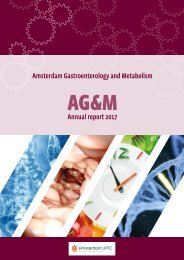AG&M annual report 2018
You also want an ePaper? Increase the reach of your titles
YUMPU automatically turns print PDFs into web optimized ePapers that Google loves.
AG&M Science Impressions <strong>2018</strong><br />
The pathogenesis and treatment of cholestatic liver diseases and itch. Unraveling<br />
Immunoglobulin G4 Associated Cholangitis and the ‘biliary HCO3- umbrella’.<br />
Ulrich Beuers and Jorrit van Niekerk<br />
Prof dr. Ulrich Beuers has been appointed Professor<br />
of Gastroenterology and Hepatology since 2007 at<br />
the Amsterdam University Medical Center and Core<br />
Professor and Head of Hepatology in 2010. After<br />
being raised in Germany, he studied medicine in Gent,<br />
Berlin and Freiburg. He obtained his Dr.med. in 1983<br />
in Freiburg. After a postdoc period in biochemistry in<br />
Göttingen, he was trained in Internal Medicine and<br />
Gastroenterology/Hepatology in Munich. During this<br />
time, he undertook a fellowship for two years at the<br />
Liver Center of the Yale University. He received his<br />
Dr.med.habil. (‘Habilitation’) in 1994 in Munich and<br />
became a Professor of Internal Medicine in 2001. In<br />
2015, he spent a sabbatical again at the Liver Center<br />
of Yale University where meanwhile a considerable<br />
number of AMC students have performed their<br />
‘wetenschappelijke stage’.<br />
For three decades, Beuers’ research focusses on<br />
the pathogenesis and treatment of patients with<br />
cholestatic liver diseases. He has supervised over<br />
20 PhDs and next to experimental laboratory work,<br />
he has initiated or participated in large clinical trials<br />
to evaluate treatment options for primary biliary<br />
cholangitis (PBC), primary sclerosing cholangitis (PSC),<br />
intrahepatic cholestasis of pregnancy (ICP) and IgG4-<br />
relaed cholangitis (IRC) of which the pathogenesis<br />
remains incompletely understood. The prognosis of PBC<br />
and PSC without treatment is dismal, the diseases often<br />
lead to liver cirrhosis and eventually the need for liver<br />
transplantation. Common to all these diseases is the<br />
symptom of pruritus (itch) which may severely affect<br />
quality of life.<br />
In search of a possible pathophysiological explanation,<br />
evidence from experimental, clinical and genetic<br />
studies led Beuers and his group to introduce the<br />
‘biliary bicarbonate umbrella hypothesis’. This<br />
hypothesis, that has been experimentally confirmed,<br />
states that cholangiocytes (and hepatocytes) create<br />
a protective apical alkaline barrier by secreting<br />
bicarbonate (HCO 3<br />
-) into the bile duct lumen. This<br />
(~30-50 nm) alkaline barrier, which is stabilized by the<br />
cholangiocyte glycocalyx, would retain bile salts in their<br />
polar, deprotonated and membrane-impermeant state.<br />
When the apical HCO 3<br />
- secretory apparatus is defective<br />
(as it is in PBC), the alkaline barrier would diminish,<br />
leading to partial protonation of bile salts, rendering<br />
the resulting bile acids apolar and capable of crossing<br />
the cholangiocyte membrane independent of bile salt<br />
transporter activity. These apolar bile acids have been<br />
shown to induce cellular damage and growth arrest.<br />
Jorrit van Niekerk is currently working as a PhD fellow<br />
under supervision of Prof. dr. Ulrich Beuers and dr.<br />
Stan van de Graaf at the Tytgat Institute for Intestinal<br />
& Liver Research on the molecular regulation and<br />
stabilization of the ‘biliary bicarbonate umbrella’ in<br />
human cholangiocytes. By a close interplay between<br />
several ion channels and proteins targeting the apical<br />
membrane in cholangiocytes a pH nanoenvironment in<br />
close proximity of the apical membrane is maintained.<br />
Our group has recently shown that the integrity of this<br />
apical layer of bicarbonate is fine-tuned by intracellular<br />
signaling pathways mediated by bile salt sensitive<br />
receptors in cholangiocytes. This enables a potential<br />
therapeutic window for endogenous and therapeutic<br />
bile salts and bile salt analogues to regulate the apical<br />
membrane expression of key elements of the ‘biliary<br />
bicarbonate umbrella’, responsible for the protection of<br />
cholangiocytes from the detergent properties of biliary<br />
bile salts in human bile.<br />
Another cholestatic liver disease entity of which the<br />
pathogenesis remains partly unknown is immunoglobulin<br />
G4-related cholangitis (IRC). Experimental work by<br />
Lowiek Hubers , PhD fellow under supervision of Prof. dr.<br />
Ulrich Beuers and dr. Stan van de Graaf , had disclosed<br />
Annexin A11 as the first IgG4/IgG1 autoantigen in IRC, and<br />
had shown that specific targeting of Annexin A11 by IgG1<br />
in patients with IRC might be attenuated by IgG4. Work<br />
by his successor, Toni Herta, suggests that the IgG4/IgG1<br />
autoantigen Annexin A11 might be a potential regulator<br />
of the intracellular trafficking of some of the key<br />
elements of the ‘biliary bicarbonate umbrella’ in human<br />
cholangiocytes. Thus, Annexin A11 dysfunction might play<br />
a role in the pathogenesis of IgG4-related cholangitis.<br />
26



